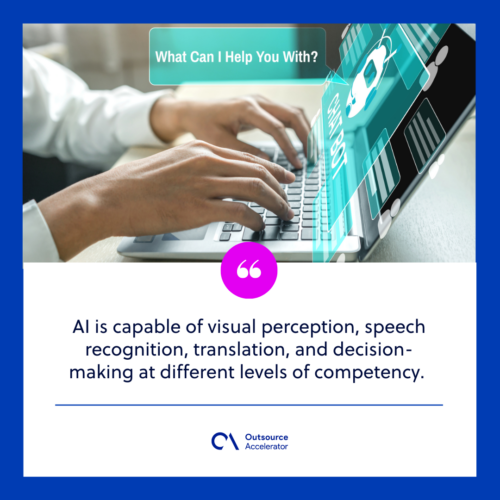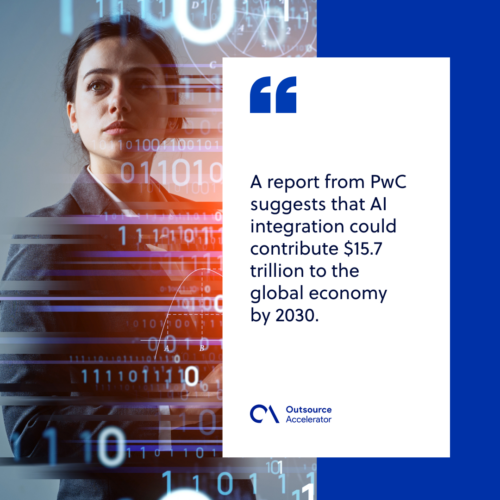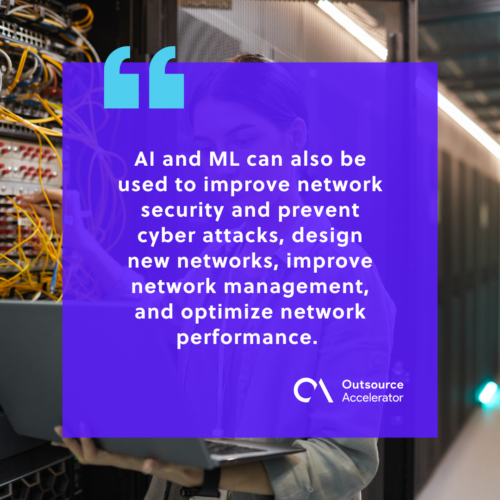The roles of AI and ML in today’s business world

It wasn’t until very recently that we’ve begun to see real advancements in the field of artificial intelligence (AI). Along with machine learning (ML), they’re becoming increasingly common in our everyday lives as industry leaders hop on the new innovation bandwagon.
AI and ML are used in various industries today, from healthcare to manufacturing to retail. And there’s no doubt that as these technologies continue to progress, we’ll see them in more aspects of our daily lives.
Defining artificial intelligence (AI) and machine learning (ML)
As two of the most important technologies in business today, organizations should be familiar with both definitions. There’s definitely a difference between AI and ML, but the terms are often used interchangeably.
What is artificial intelligence (AI)?
Artificial intelligence (AI) is the ability of computers to perform tasks that normally require human intelligence. AI is capable of visual perception, speech recognition, translation, and decision-making at different levels of competency.
AI is developed mainly to reduce the work of humans. It is made to emulate the human trait of learning from experience to solve problems, even without being programmed explicitly.
What is machine learning (ML)?
Machine learning (ML) is actually a subset of artificial intelligence. ML specifically teaches computers to learn by parsing data to identify patterns.
Machine learning algorithms take in large amounts of data to find patterns that humans might not otherwise have found. The process is essentially a form of data analysis that trains computers to predict future events and outcomes from their findings.

Key differences between AI and ML
A helpful metric to remember is that all types of ML are considered AI, but not all kinds of AI are ML.
To further define the two, it’s helpful to examine their differences:
Applications of AI and ML in different sectors
A report from PwC suggests that AI integration could contribute $15.7 trillion to the global economy by 2030. The research also shows that 45% of total economic gains will come from the product enhancements that AI and ML will deliver.
AI and ML are rapidly changing the way we work and live. They already have a deep presence in our lives, being used in many industries to accelerate production and increase efficiency.

Healthcare and life sciences
There are already numerous ways that AI and ML have found their way into the healthcare sector.
Some examples include:
- Data analytics – AI and ML can identify trends and patterns from medical records and patient histories to predict future diagnoses. This can also improve treatment plans and reduce patient costs.
- Patient care – AI and ML, along with robotics, assist nurses and caregivers by performing tasks like dispensing medication and monitoring.
- Medical imaging analysis – AI and ML can be used to analyze medical images more efficiently and accurately than human doctors alone.
- Surgery – surgeons use robotics to perform more accurate and precise operations.
- Drug discovery and development – AI and ML algorithms can be useful to pharmaceutical companies by scanning thousands of chemical compounds in record time and identifying those that will have a high likelihood of success.
Ecommerce and retail
AI and ML process orders more efficiently through automated inventory management systems, but their real value in the retail industry is providing personalized customer experiences. Doing so also reduces costs and increases revenue.
By analyzing user data from online platforms, AI and ML can determine trends in customer preferences over time. This information can then advise businesses which products should be marketed to which customers and when.
AI and ML also go further and offer recommendations for other products and services that people may be interested in.
Firms can partner with leading third-party providers like Datamatics to fulfill their AI and ML requirements.
Financial services
Financial services have been using AI as early as 1982. The quantitative hedge-fund Renaissance Technologies leveraged data to analyze statistical probabilities for the trend in security prices in any market.
This practice continues today, and AI and ML have gone on to automate tasks like fraud detection and risk management as well. This trend will only grow as more people shift to online banking.
Telecommunications
The telecommunications industry is constantly investing in new ways to offer more personalized and efficient customer service. AI and ML can analyze large amounts of data to provide predictive insights on customer behavior and queries.
AI and ML can also be used to improve network security and prevent cyber attacks, design new networks, improve network management, and optimize network performance.
Manufacturing
Manufacturing is one of the most common sectors where AI and ML are deployed, from smart factory systems to self-driving cars.
AI and ML are used to optimize scheduling and planning in factories and also for developing software that predicts machine breakdowns. This technique improves efficiency and reduces waste.
AI and ML are present throughout the whole manufacturing process, up to quality control and traceability.
Energy
The energy sector is being recognized as the next sector where AI and ML can rapidly grow.
Companies are looking for new solutions to make solar power, in particular, more powerful and cost-efficient through AI and ML. But these cutting-edge technologies are being developed in this sector to reduce reliance on all fossil fuels.
Additionally, AI and ML can be used to manage physical assets and processes, including:
- Improving efficiency in power generation and distribution
- Enhancing the reliability of electric grids
- Helping the supply chain for renewable energy sources
- Reducing carbon dioxide emissions from power plants
AI and ML: Transforming the future of businesses
All-in-all, the future of AI and ML in business looks promising. As more developers and reputable third-party solutions provider like OP360 take on AI initiatives to improve existing capabilities, everyday life will be significantly improved.
Still, some core problems remain unsolved. Regulation is always a hot topic when it comes to AI and ML, and we must ensure that the detrimental effects on human livelihood are minimized.
The horizon of AI and ML looks bright, and it’s exciting to look forward to what other innovations, like nanotechnology or biological engineering, the future will bring.









 Independent
Independent




